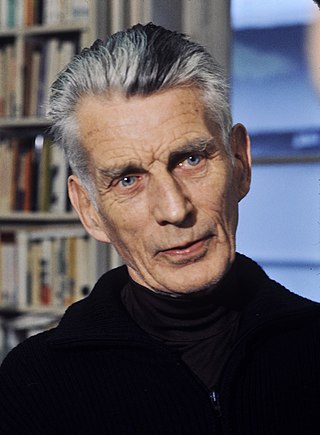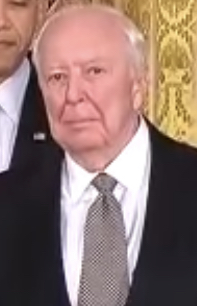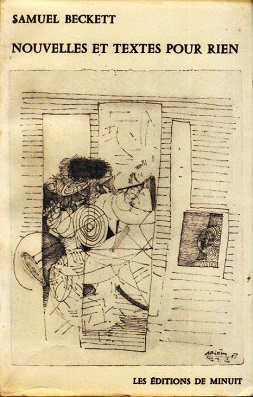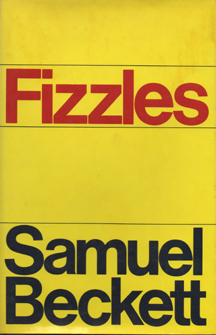
Samuel Barclay Beckett was an Irish novelist, dramatist, short story writer, theatre director, poet, and literary translator. His literary and theatrical work features bleak, impersonal and tragicomic experiences of life, often coupled with black comedy and nonsense. It became increasingly minimalist as his career progressed, involving more aesthetic and linguistic experimentation, with techniques of repetition and self-reference. He is considered one of the last modernist writers, and one of the key figures in what Martin Esslin called the Theatre of the Absurd.

Waiting for Godot is a play by Samuel Beckett in which two characters, Vladimir (Didi) and Estragon (Gogo), engage in a variety of discussions and encounters while awaiting the titular Godot, who never arrives. Waiting for Godot is Beckett's translation of his own original French-language play, En attendant Godot, and is subtitled "a tragicomedy in two acts". The original French text was composed between 9 October 1948 and 29 January 1949. The premiere, directed by Roger Blin, was on 5 January 1953 at the Théâtre de Babylone, Paris. The English-language version premiered in London in 1955. In a poll conducted by the British Royal National Theatre in 1998/99, it was voted the "most significant English-language play of the 20th century".

Jasper Johns is an American painter, sculptor, and printmaker whose work is associated with abstract expressionism, Neo-Dada, and pop art. He is well known for his depictions of the American flag and other US-related topics. Johns's works regularly sell for millions of dollars at sale and auction, including a reported $110 million sale in 2010. At multiple times works by Johns have held the title of most paid for a work by a living artist.

Milton Ernest "Robert" Rauschenberg was an American painter and graphic artist whose early works anticipated the Pop art movement. Rauschenberg is well known for his Combines (1954–1964), a group of artworks which incorporated everyday objects as art materials and which blurred the distinctions between painting and sculpture. Rauschenberg was both a painter and a sculptor, but he also worked with photography, printmaking, papermaking and performance.
Les Éditions de Minuit is a French publishing house. It was founded in 1941, during the French Resistance of World War II, and is still publishing books today.
Anthony Gerard Richard Cronin was an Irish poet, arts activist, biographer, commentator, critic, editor and barrister.
Events from the year 1976 in art.
Events from the year 1930 in art.

Molloy is a novel by Samuel Beckett first written in French and published by Paris-based Les Éditions de Minuit in 1951. The English translation, published in 1955, is by Beckett and Patrick Bowles.
Brice Marden is an American artist generally described as Minimalist, although his work may be hard to categorize. He lives and works in New York City; Tivoli, New York; Hydra, Greece; and Eagles Mere, Pennsylvania.

Stan Douglas is an artist based in Vancouver, British Columbia.
For the song "That Time" by Regina Spektor see Begin to Hope
Mark Stock was an American painter. He was born in Frankfurt, Germany, in 1951. The son of an Army officer, Stock lived in many states across America before settling in St. Petersburg, Florida. He received his Bachelor of Arts degree from the University of South Florida in Tampa, where he studied under Theo Wujcik. Upon graduating in 1976, Stock was hired to work at Gemini G.E.L. in Los Angeles as a lithographer. While there, he printed for notable artists such as Jasper Johns, David Hockney, Robert Rauschenberg, and Roy Lichtenstein before leaving to paint full-time.

Mercier and Camier is a novel by Samuel Beckett that was written in 1946, but remained unpublished until 1970. Appearing immediately before his celebrated "trilogy" of Molloy, Malone Dies and The Unnamable, Mercier et Camier was Beckett's first attempt at extended prose fiction in French. Beckett refused to publish it in its original French until 1970, and while an English translation by Beckett himself was published in 1974, the author had made substantial alterations to and deletions from the original text while "reshaping" it from French to English.

Stories and Texts for Nothing is a collection of stories by Samuel Beckett. It gathers three of Beckett's short stories and the thirteen short prose pieces he named "Texts for Nothing"(1950–1952). All of these works are collected in the Grove Press edition of Beckett's complete short prose. They were originally written in French and published in 1955 by Les Éditions de Minuit as Nouvelles et Textes pour rien, with a second edition illustrated edition published by the same publisher in 1958.
The Arion Press in the United States book publishing company founded in San Francisco in 1974. It has published 120 limited-edition books, most printed by letterpress, often illustrated with original prints by notable artists. Minneapolis Star Tribune described it as "the nation's leading publisher of fine-press books".

The Complete Short Prose 1929–1989 is a collection which includes all of Samuel Beckett's works written in prose, with the exception of his novels, novellas from Nohow On, and More Pricks Than Kicks which is considered "as much a novel as a collection of stories". The book was edited by S. E. Gontarski and published by Grove Press in 1995.

Aldo Crommelynck was a Belgian master printmaker who made intaglio prints in collaboration with many important European and American artists of the 20th century.
Judith Goldman is a writer, curator and publisher who lives in New York City.










